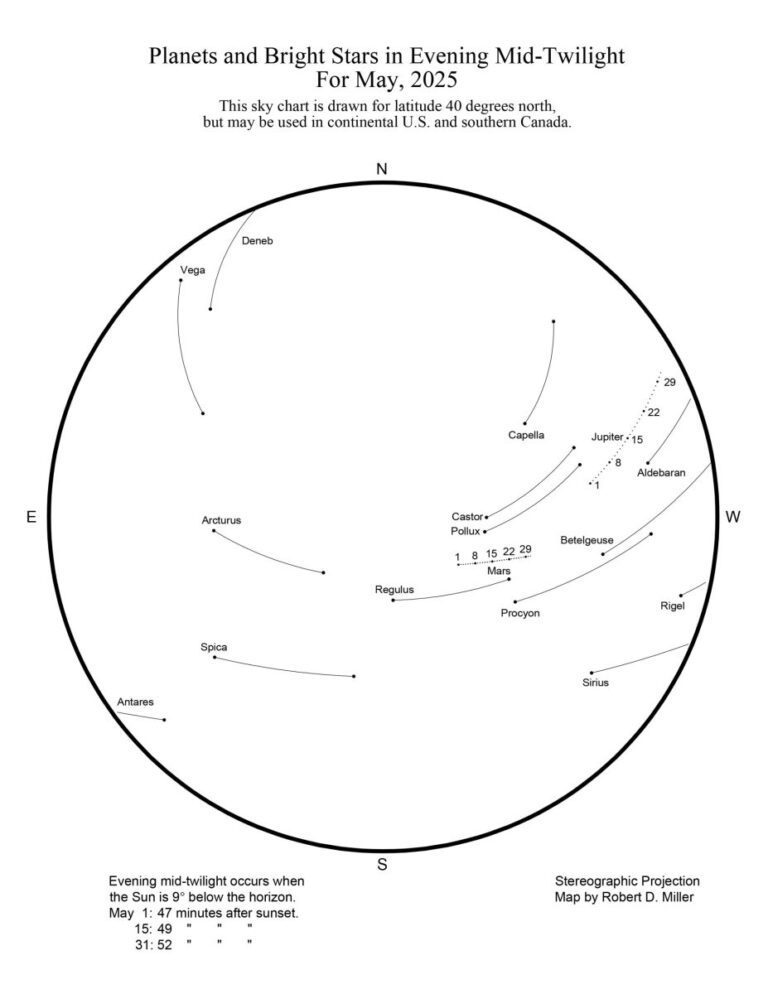May 2025 Celestial Events: A Stargazer’s Guide
Overview of the Night Sky
Binoculars are an essential tool for enhancing the experience of sky-watching. However, it is important to note that the recently identified comet C/2025 F2 (SWAN) will not be observable through the naked eye or binoculars due to its disintegration during its close approach to the sun.
Observation Opportunities
For those eager to explore the night sky in May 2025, the Abrams Planetarium offers free downloadable resources, including the Sky Calendar and a constellation map. The calendar provides a visual guide to the celestial sphere approximately 1.25 hours post-sunset, aiding in star-hopping from Jupiter to key stars like Aldebaran, the Hyades, and the Pleiades.
Asteroid Vesta
Another exciting observation will involve the asteroid Vesta, discovered in 1807. Vesta reaches opposition at a brightness of magnitude +5.7 on May 1, making it visible to the naked eye on dark nights, especially when located within the triangular area formed by the stars Mu in Virgo, 16 in Libra, and 11 Librae.
Notable Stars and Events
Evening Sky Highlights
At the beginning of May, several prominent winter stars, including Rigel, Aldebaran, and Sirius, will be visible in the western part of the sky as twilight fades. Observers can use binoculars to trace these stars deeper into the twilight, utilizing the evening mid-twilight map that depicts the sky when the sun is 9° below the horizon.
Binocular Views of the Moon
Throughout May, the moon will engage in interesting conjunctions with various celestial bodies. Key dates include:
- May 2: Moon near Pollux and Castor
- May 3: Moon, Mars (magnitude 1.0), and the Beehive cluster
- May 5: Moon positioned close to Regulus
- May 9: Moon aligned with Spica
On the evening of May 13, the waning gibbous moon will drift past Antares, creating another beautiful sight for binocular enthusiasts.
Morning Observations
Morning Planets
Venus, shining at magnitude -4.7, will rise shortly before twilight throughout the month. From latitude 40° N, its crescent phase will progress from 29% illuminated on May 1 to 49% by May 31. Saturn will also be visible, positioned 3.9° below Venus on May 1, and presenting a unique opportunity as its rings become more illuminated following Earth’s crossing of the ring plane on March 23.
Meteor Shower Events
May 6 will mark the peak of the Eta Aquariid meteor shower, originating from Halley’s Comet. Observers should find a dark location two hours before sunrise to enjoy this spectacular event.
Stellar Phenomena and the Milky Way
During the early mornings of May, stargazers can best appreciate the Milky Way just before twilight starts to brighten, particularly from May 1-7 and May 25-31. The bright patches of the Milky Way highlight key regions such as the Cygnus Star Cloud and the Greater Sagittarius Star Cloud, offering a treasure trove of binocular targets including star clusters and nebulae.


